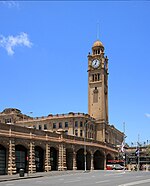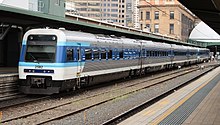Sydney Central Station
| Sydney Central Station | |
|---|---|
 Sydney Central Station
|
|
| Data | |
| Design |
End station (long-distance traffic) through station ( CityRail ) |
| Platform tracks | 27 (25 used) |
| opening | 4th August 1906 |
| Architectural data | |
| Architectural style | Neo-renaissance |
| architect | Walter Liberty Vernon |
| location | |
| City / municipality | Sydney |
| State | New South Wales |
| Country | Australia |
| Coordinates | 33 ° 53 '0 " S , 151 ° 12' 18" O |
| Height ( SO ) | 30 m |
| List of train stations in Australia | |
Sydney Central Station (also: Sydney Terminal ) is the main train station of Sydney , the largest train station in Australia and thus also the railway in New South Wales . It has 27 platform tracks, four of which are underground and two of which are not used for rail traffic. They are numbered from west to east.
location



The station is located south of downtown Sydney on Railway Square , with the official mailing address being Haymarket . Belmore Park is next to the train station .
history
In the area occupied by the station today, there were a total of three stations. The first was the Redfern railway station . This went into operation with the first railway line, which started from Sydney, on September 26, 1855. The station building had only one platform in a corrugated iron hall. This first small train station was replaced because it was no longer able to cope with the traffic. At the same location, a new station was built in 1874, initially with 2 tracks, the number of which increased to 14 platform tracks over time. Finally, in 1906 - the station was no longer able to cope with the increased traffic - today's facility was built. It is located a few meters further north than the predecessor complex and thus built over a former cemetery, among other things . Buried people had to be reburied .
The reception building was built in the neo-renaissance style according to a design by the state architect Walter Liberty Vernon . With a great deal of stonemasonry work in the locally widespread Sydney sandstone , facades and interiors were designed. The cross platform is spanned by a large station hall . The 75 meter high clock tower that dominates the building today was not added until 1920/21. The reception building is classified as a cultural monument.
The structures also include the Sydney Regent Street Station “cemetery station” , a special reception building so that the coffin and the funeral guests could be taken by train to Rookwood cemetery, where there was a corresponding reception building.
The new station had 15 platform tracks, opened on August 4, 1906 and went into operation the following day. It still serves as Sydney Central Station today. The increasing traffic was absorbed by the fact that the station was expanded in an easterly direction.
In 1916, the train station and the surrounding hotels were the main scene of a mutiny by soldiers who revolted against their inadequate accommodation in camps.
Investments
The train station today consists of two adjacent systems that differ in many ways. The western part of 1906 is a terminus , Sydney Terminal . Three of its 15 platform tracks are used for long-distance traffic within New South Wales and beyond, the remainder for local traffic. West of track 1 there were still two tracks for mail trains . After this service was discontinued, a track of the facility was rebuilt and is now used for loading cars on the Indian Pacific . The other track was built over with a youth hostel , the building of which was modeled on old railroad cars.
The eastern section of the station is a through station , mainly for the Sydney S-Bahn , which also functions as a subway in the city center . This system was added in 1926. Eight of the platform tracks are above ground, in an elevated position, so that road traffic in front of the historic part of the facility can be driven over on a viaduct. Four more platforms were built underground from 1948, but did not go into operation until 1979 because of the delayed connection of the Eastern Suburbs Line , which they were supposed to serve. However, only two tracks are required for their operation, so that the space occupied by the other two is currently used by the New South Wales Railways to archive documents .
traffic
train
Every hour between 27 and 32 trains run in each direction in the station, and more during rush hour . Almost all CityRail lines go to the station. It is the central transfer point and hub of the city's public transport .
In long-distance traffic, Country Link serves destinations in New South Wales and connections to Brisbane and Melbourne . The “parade train” of the Australian railroad , the Indian Pacific of the Great Southern Railway , departs from here twice a week, always from platform 1.
connections
Central Station is also the eastern terminus of the Metro Light Rail , the only tram currently operating in Sydney . To do this, she drives under the loggia in front of the reception building . That is what it was originally intended for. But in 1958 the station lost its connection to the tram that had existed until then.
Numerous local bus routes in Sydney and some long-distance routes serve stops at the train station.
literature
- Robert McKillop et al. a .: A Century of Central . Australian Railway Historical Society, NSW Division. 2008. ISBN 978-0-9757870-6-9
- Ronald George Preston: 125 Years of the Sydney to Parramatta Railway . The New South Wales Rail Transport Museum. Burwood 1980. ISBN 0-909862-13-3
Web links
- Trainman's Trainpage - Photos of unused platforms 26 and 27.
- Central Station - self guided tour
Individual evidence
- ^ NN: Heritage of Australia . Macmillan Publishers 1981. pp. 2/108.






